A Silver Trowel
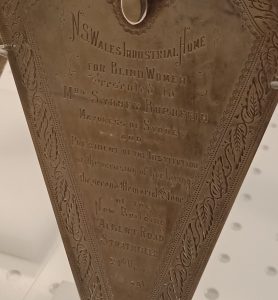
Ceremonial silver trowel made by Hardy Brothers on display at State Library of NSW, 18 July 2024. Courtesy Strathfield Local Studies
Currently on display in the State Library of NSW’s cabinet of objects is a silver trowel used to lay a memorial stone at the NSW Industrial Home for Blind Women in Albert Road, Strathfield on 24 March 1891. Local residents will recognise the building as the Catholic Institute of Sydney at 99 Albert Road.
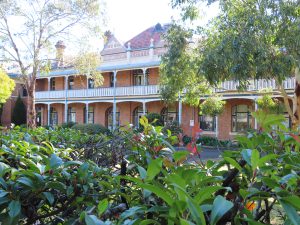
Catholic Institute of Sydney, 26 July 2024. Courtesy Strathfield Local Studies
The building was designed by local architect, Harry Kent in response to a competition. The winning design was selected because it incorporated the principles of simplicity and regularity in the arrangement of rooms and corridors for the benefit of its residents. Twelve bedrooms would accommodate 48 ladies on the first floor. Interestingly, Kent also designed the building to accommodate another future storey if required.[1] This was never added. The Home would teach residents a range of trades allowing them to make household items for sale. These included: clotheslines, brushes, halters, doormats, buggy mats and knitted goods.[2]
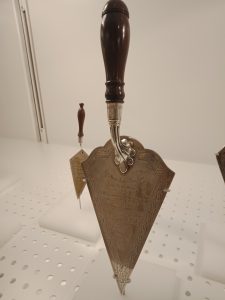
Ceremonial silver trowel made by Hardy Brothers on display at State Library of NSW, 18 July 2024. Courtesy Strathfield Local Studies
Three ceremonial stones were laid on this day and Kent presented engraved silver trowels and mallets, made by silversmiths Hardy Brothers, to each of the ladies invited to perform ceremonial duties. Coincidentally, John Hardy was also a Strathfield local, then resident of Strathfield House.This particular trowel was used to lay the second stone and was presented to Catherine Burdekin, the wife of Sydney’s Lord Mayor. The first stone was laid by the Governor’s wife, Lady Jersey with Mrs H.S. Prescott, secretary of the committee, laying the third stone. These two stones are still visible from the verandah of the Catholic Institute, however that laid by Mrs Burdekin has not been located.
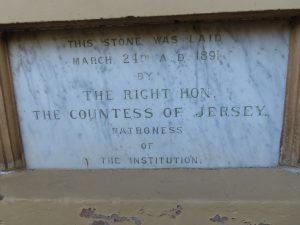

Marble stones laid on 24 March 1891. Courtesy Strathfield Local Studies.
Mr and Mrs Prescott were the founders of the movement and Mr Prescott was himself also blind. A temporary home for blind women with 15 residents was then in operation at Petersham.
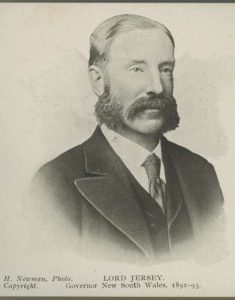
Lord Jersey, Governor of NSW. Courtesy National Library of Australia
Lord Jersey had arrived in Sydney from Britain as Governor of NSW a short time earlier in January 1891. His wife, ill with typhoid fever, did not arrive until March 1891 – the same month as she was welcomed to Strathfield. Jersey’s tenure as Governor was relatively brief as he resigned in November 1892 and left Sydney in March 1893.[3] Upon receiving the first silver trowel and mallet Lady Jersey assured Mr Kent that she would keep them ‘in remembrance of the Home and his kindness.’[4]
Sydney Burdekin, wealthy pastoralist and politician, served as an alderman of Sydney Municipal Council from 1883 to 1898 and as mayor from January 1890 to April 1891 when he resigned to travel overseas.[5] His wife, Catherine, was President of the Industrial Home for the Blind during 1891.[6] Burdekin, also a magistrate, served as a director of Sydney Hospital for more than 20 years.
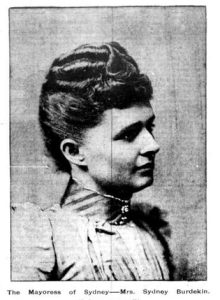
Australian Town and Country Journal 1 February 1890 p.34
In the days after their visit to Strathfield the newspapers reported on the occasion in great detail. The vice-regal party, including Mrs Burdekin, had been met at Homebush Station by the Mayor of Strathfield, Mr Albert Allen who presented an address on behalf of residents to which the Governor responded. Pupils from Eton College in Redmyre Road, accompanied by their headmaster, David Sly then welcomed the party most eloquently. The Governor was delighted as he had been a student at Eton College in the UK. He expressed a desire to present a sporting award at the Strathfield college in the future. However by July the following year Sly was bankrupt and the school was forced to close.[7] Homebush Station was decorated with flags, evergreens and flowers for the occasion and ‘the road from the … station to the building was carpeted and likewise decorated.’[8]
But that wasn’t all. ‘At the Boulevard, opposite the residence of Herr Wilhelm von der Heyde, that gentleman had caused a magnificent arch to be erected, 30ft. high, with smaller arches on either side. It was such a massive structure and in so charming a spot that, at the suggestion of the mayoress of Sydney, steps are being taken to ensure its remaining as a fountain upon which climbing plants may be trained and as a permanent ornament to the place.’[9]
Strathfield Council minutes of a special meeting held to plan the event on 19 March 1891 noted that:
‘Mr Heyde undertook to see Mr Kent the architect for the building in reference to the erection of an arch in Albert Rd.’
It is unclear what became of the arch.
Minutes of the committee meeting of 23 March record the address that was planned for the following day:
‘Your Excellency and Lady Jersey,
On behalf of this council and the residents of the Municipality of Strathfield I have the honor on this your first visit to our suburb on the occasion of laying the foundation stone of the Industrial Home for Blind Women to offer you both a heart welcome. We venture to think that Homebush has not been inaptly chosen for the establishment of the institution which you are about to inaugurate this afternoon both on account of the well known salubrity of the climate of Homebush and its accessibility to the metropolis. We trust that this will not be the only occasion when we shall be honoured by your presence among us.
Mayor, Albert Allen’
The site in Albert Road had been purchased for £1650 and the cost of construction of the home was expected to be £8595. At the time of the stone laying ceremony, just over £4200 had been raised, including a donation of £200 from the indomitable Miss Eadith Walker of Yaralla, Concord.[10] On the day itself, Dean Cowper presided over the reception and further donations of £116 were placed upon the first stone ceremonially laid by Lady Jersey. Afterwards the dignitaries were entertained to afternoon tea at the Strathfield Council Chambers before being escorted back to Homebush Station for their return trip to the city.
The Home was opened almost exactly one year later on 21 March 1892 by the then Mayoress of Sydney, Mrs Manning with the assistance of the then Mayor of Strathfield, Mr John Hinchcliff who lived at Milroy, nearby.[11] The Home’s apartments would occupy the centre of the building, flanked on the western side by the future concert hall (which was never built) and on the eastern side by a private dwelling, with the kitchen and servants’ quarters at the rear. Further details about the design and layout of the building can be found at: https://trove.nla.gov.au/newspaper/article/162178984

The Sydney Mail and New South Wales Advertiser 26 March 1892 p.702
However, for all its grand beginning, the Home survived for less than ten years. By 1897, amid distressing allegations of impropriety, abuse and financial mismanagement, a Royal Commission was appointed to investigate. The serious findings led to the demise of the Strathfield Home and its residents were relocated.[12] Truth also reported on the story[13] and subsequently fought a libel case.[14] By March 1900 only ten women remained in the Home.[15] The Sydney Industrial Blind Institution Incorporation Act 1901 (later the Royal Blind Society of New South Wales Act 1901) sought to control the activities, powers and liabilities of future bodies to prevent future mismanagement.
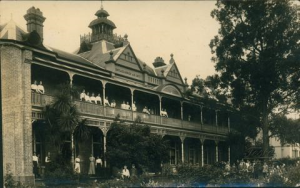
Postcard of Bedford College in the Olive Pink collection, University of Tasmania
The lovely building in Albert Road was put up for sale and became known as Bedford College, a school for young ladies. It has had a number of other uses over the years and since 1995 has served as the Catholic Institute of Sydney.
By J.J. MacRitchie
Local Studies Advisor
References
[1] Sydney Morning Herald 25 March 1891 p.5 https://trove.nla.gov.au/newspaper/article/13818750[2] Sydney Morning Herald 25 March 1891 p.5 https://trove.nla.gov.au/newspaper/article/13818750
[3] Cunneen, Chris ‘Seventh Earl of Jersey’ in Australian Dictionary of Biography https://adb.anu.edu.au/biography/jersey-seventh-earl-of-6844
[4] The Sydney Mail and New South Wales Advertiser 28 March 1891 p.693 https://trove.nla.gov.au/newspaper/article/163650794
[5] Humphries, Shirley ‘Sydney Burdekin (1839-1899)’ in Australian Dictionary of Biography https://adb.anu.edu.au/biography/burdekin-sydney-3331
[6] Sydney Morning Herald 30 January 1891 p.6 https://trove.nla.gov.au/newspaper/article/13812466
[7] Jones, Cathy. Strathfield Heritage ‘Eton College Redmyre Road’ https://strathfieldheritage.com/streetnames/redmyre-road-strathfield/eton-college-redmyre-road/
[8] The Sydney Mail and New South Wales Advertiser 28 March 1891 p.693 https://trove.nla.gov.au/newspaper/article/163650794
[9] The Sydney Mail and New South Wales Advertiser 28 March 1891 p.693 https://trove.nla.gov.au/newspaper/article/163650794
[10] Evening News 26 March 1891 p.2 https://trove.nla.gov.au/newspaper/article/114309694
[11] The Sydney Mail and New South Wales Advertiser 26 March 1892 p.702 https://trove.nla.gov.au/newspaper/article/162178984
[12] Sydney Morning Herald 29 June 1898 p.5 https://trove.nla.gov.au/newspaper/article/14135635
[13] Truth 21 August 1898 p.5 https://trove.nla.gov.au/newspaper/article/168083346
[14] Truth 10 September 1899 p.4 https://trove.nla.gov.au/newspaper/article/168084581
[15] Sydney Morning Herald 20 March 1900 p.6 https://trove.nla.gov.au/newspaper/article/14300956
